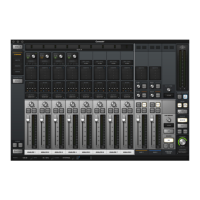Apollo Thunderbolt Software Manual Glossary 216
Firmware Software that is embedded in hardware.
Flex Routing Apollo technology that enables its physical inputs to be routed to various
physical outputs. Compare to Virtual I/O.
FPGA Acronym for “Field Programmable Gate Array.” A type of integrated circuit that can
be programmed after manufacturing (“in the field”) to perform specialized functions.
Front End Refers to a device that provides analog and digital input/output (I/O) to a
digital audio workstation (DAW). Apollo is a front end.
Graphical User Interface A software window, panel, or screen containing controls where
parameters are adjusted by the user. (See “GUI”)
GUI Acronym for Graphical User Interface.
Hi-Z Abbreviation for “High Impedance.” Apollo’s Hi-Z input allows direct connection of
an instrument such as electric guitar or bass via a standard unbalanced ¼” jack.
High Resolution In digital audio, refers to 24-bit signals at sampling rates of 88.2 kHz or
higher.
Hz Abbreviation for “Hertz,” a unit of measurement describing a single analog audio
cycle (or digital sample) per second.
Impedance A description of a circuit’s resistance to a signal, as measured in ohms,
thousands of ohms (Kilohms), or millions of ohms (megohms).
Internal Clock A clock signal derived from onboard circuitry. (See “Clock”)
I/O Acronym for “input/output.”
I/O Matrix Apollo technology that enables customized I/O mapping at the Core Audio /
ASIO driver level.
kHz Abbreviation for “kiloHertz” (a thousand Hertz), a unit of measurement describing a
thousand analog audio cycles (or digital samples) per second. (See “Hz”)
JFET Acronym for Junction Field Effect Transistor, a specific type of FET which has some
similarities to traditional bipolar transistor designs that can make it more appropriate for
use in some audio circuit designs. (See “FET”)
Jitter Refers to short-term variations in the edges of a clock signal, caused by a bad
source clock, inferior cabling or improper cable termination, and/or signal-induced noise.
A jittery signal will contain spurious tones at random, inharmonic frequencies. Usually,
the jitter will be worse with higher signal frequencies. The internal digital clock of
Apollo was designed for extreme stability and jitter-free operation, and its onboard phase
aligned clock conditioner circuitry removes jitter from external sources, so conversion
quality is uneffected by clock source.
Lightpipe A digital connection made with optical cable. This was a phrase coined by
Alesis to make a distinction between the proprietary 8-channel optical network used
in their ADAT products and standard stereo optical connectors used on CD players and
other consumer products.

